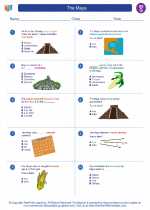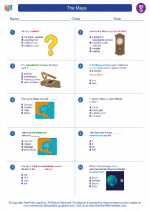The Maya
In the 1st century, a group of people called the Maya rose to civilization in Central and South America. Their society was very interactive and organized around individual city states, each with their own governmental system. They created a system of writing which consisted of individual symbols to represent sounds and words. Read More...
◂Social Studies Worksheets and Study Guides Seventh Grade. The Maya
Study Guide The Maya
The Maya  Worksheet/Answer key
Worksheet/Answer key The Maya
The Maya  Worksheet/Answer key
Worksheet/Answer key The Maya
The Maya  Worksheet/Answer key
Worksheet/Answer key The Maya
The Maya 

 Worksheet/Answer key
Worksheet/Answer key
 Worksheet/Answer key
Worksheet/Answer key
 Worksheet/Answer key
Worksheet/Answer key

The resources above cover the following skills:
National Curriculum Standards for Social Studies (NCSS)
TIME, CONTINUITY, AND CHANGE
SOCIAL STUDIES PROGRAMS SHOULD INCLUDE EXPERIENCES THAT PROVIDE FOR THE STUDY OF THE PAST AND ITS LEGACY.
KNOWLEDGE - Learners will understand:
The study of the past provides a representation of the history of communities, nations, and the world.
That learning about the past requires the interpretation of sources, and that using varied sources provides the potential for a more balanced interpretive record of the past.
That historical interpretations of the same event may differ on the basis of such factors as conflicting evidence from varied sources, national or cultural perspectives, and the point of view of the researcher.
Key historical periods and patterns of change within and across cultures (e.g., the rise and fall of ancient civilizations, the development of technology, the rise of modern nation-states, and the establishment and breakdown of colonial systems).
The contributions of key persons, groups, and events from the past and their influence on the present.
The influences of social, geographic, economic, and cultural factors an the history of local areas, states, nations, and the world.
National Center for History in Schools (NCHS)
Historical Thinking Standards
Chronological Thinking
Identify the temporal structure of a historical narrative or story.
Reconstruct patterns of historical succession and duration; explain historical continuity and change.
Historical Comprehension
Reconstruct the literal meaning of a historical passage.
Identify the central question(s) the historical narrative addresses.
Historical Analysis and Interpretation
Draw comparisons across eras and regions in order to define enduring issues.
Challenge arguments of historical inevitability.
Hold interpretations of history as tentative.
Historical Research Capabilities
Formulate historical questions.
Historical Issues-Analysis and Decision-Making
Identify issues and problems in the past.
Identify relevant historical antecedents.
United States History Content Standards
Era 1: Three Worlds Meet (Beginnings to 1620)
Comparative characteristics of societies in the Americas, Western Europe, and Western Africa that increasingly interacted after 1450.
The student understands the differences and similarities among Africans, Europeans, and Native Americans who converged in the western hemisphere after 1492.
How early European exploration and colonization resulted in cultural and ecological interactions among previously unconnected peoples.
The student understands the stages of European oceanic and overland exploration, amid international rivalries, from the 9th to 17th centuries.
World History Content Standards
Era 4: Expanding Zones of Exchange and Encounter, 300-1000 CE
The rise of centers of civilization in Mesoamerica and Andean South America in the first millennium CE.
The student understands the origins, expansion, and achievements of Maya civilization.
Major global trends from 300-1000 CE.
The student understands major global trends from 300 to 1000 CE.